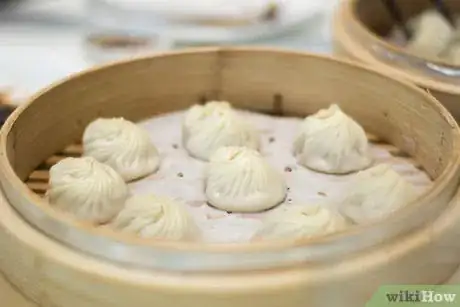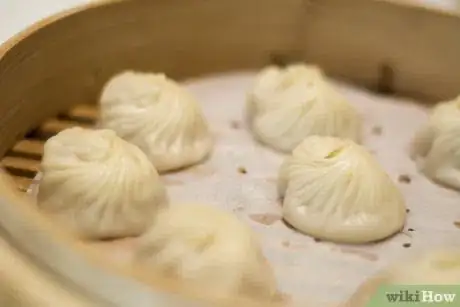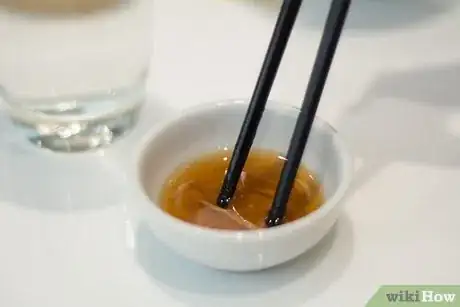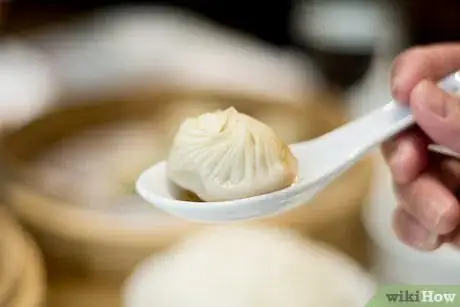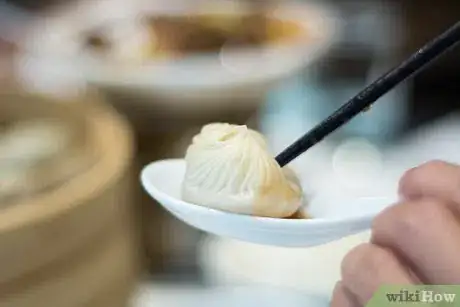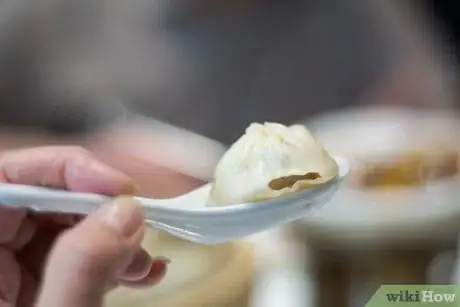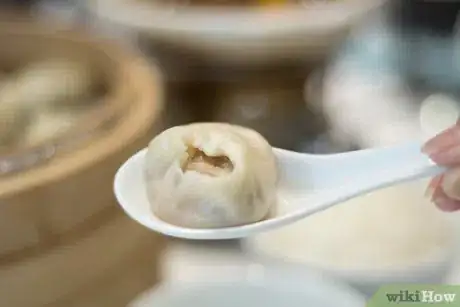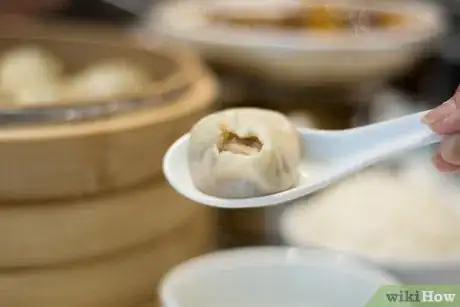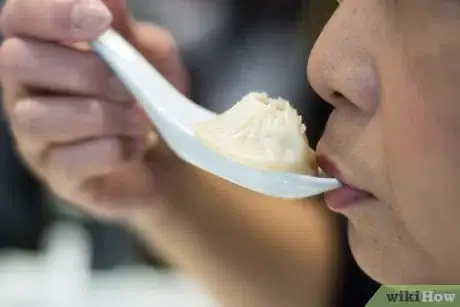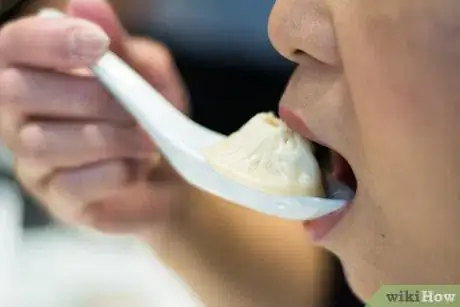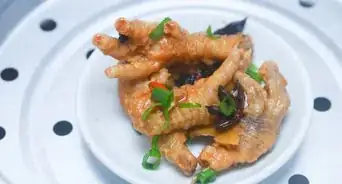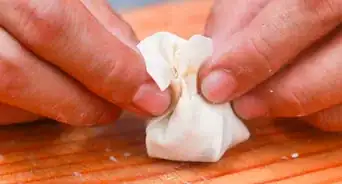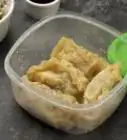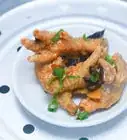This article was co-authored by wikiHow Staff. Our trained team of editors and researchers validate articles for accuracy and comprehensiveness. wikiHow's Content Management Team carefully monitors the work from our editorial staff to ensure that each article is backed by trusted research and meets our high quality standards.
This article has been viewed 15,647 times.
Learn more...
Soup dumplings (also called xiaolongbao or steamed dumplings) are a delicious lunch or dinner option. Pillows of dough stuffed with vegetables or meat are filled with broth and steamed, served hot in a bamboo basket. You shouldn’t, however, bite right into a soup dumpling. You’ll first need to let the dumplings cool. After transferring the dumpling from the basket to your spoon, you’ll want to puncture it to allow the steam and broth to escape. You can then enjoy the broth and dumpling with or without a touch of dark vinegar.
Steps
Picking up the Dumpling
-
1Remove the cover from the dumpling basket to let the dumplings cool. It is important you allow the dumplings to cool, because the hot soup pumped inside them can easily burn your mouth or tongue. After your server delivers the basket of dumplings to your table, use your hands to gently remove the lid from the basket. Be aware that steam may exit the basket quickly, so exercise caution when removing the lid from the basket.[1]
- You can also use chopsticks to remove the lid from the dumpling basket.
- If you are concerned about being burned by the steam escaping the basket, ask the server to remove the lid.
-
2Allow the dumplings to sit uncovered for 60 seconds. When you let the dumplings cool, the skin of the dumplings will begin to gelatinize. This brief cooling process also helps toughen up the dumpling skin. This will make the dumpling more durable for the journey from the basket to your spoon.[2]
- Soup dumpling skins are very fragile, making the cooling process critical for a successful dumpling eating experience.
- Do not let the soup dumplings cool for too long, as this can make the dumpling skin hard.
Advertisement -
3Scoop 1⁄4 teaspoon (1.2 mL) vinegar into your soup spoon. Soup dumplings are generally served with a large soup spoon and a side of dark vinegar. Hold the soup spoon with your non-dominant hand, which is the hand you do not generally use for writing or eating. Place the spoon in the vinegar dish, and gently scoop about 1⁄4 teaspoon (1.2 mL) into the soup spoon.[3]
- The vinegar will add flavor to the dumpling when you consume it.
- If you would rather enjoy the flavors of the broth on their own, you can skip adding vinegar to the soup spoon.
-
4Dip your chopsticks in vinegar so they don’t stick to the dumpling. Soup dumplings can sometimes stick to the bottom of the dumpling basket, to the sides of other dumplings, or to your chopsticks. Dipping your chopstick in vinegar will help prevent the utensil from sticking to the fragile dumplings, stopping an unwanted puncture or hole from forming.[4]
- You can dip the chopsticks into the vinegar-filled soup spoon.
- You can also dip the chopsticks directly into the dish of vinegar.
-
5Pick up the dumpling with the chopsticks and transfer it to the spoon. Use the chopsticks to grab the top of the dumpling, grasping it right below the ring-shaped knot. The ring of dough skin, or the dumpling knot, is located right above the series of crimps that lead to the top of the dumpling. Gently transfer the dumpling to the soup spoon.[5]
- Use a little bit of leverage to gently pull the dumpling from the basket from all sides.
- As you remove the dumpling, you will clearly be able to see the waterline where the soup ends above the middle of the dumpling.
Piercing the Dumpling
-
1Poke a hole in the dumpling with a chopstick to slowly release steam. If you want a slow, leisurely escape of steam from the dumpling, or if you’re not interested in biting directly into the dumpling, choose the chopstick method. Gently poke a hole in the side of the dumpling. Allow the steam to escape as the broth fills your spoon.[6]
-
2Take a bite out of the dumpling’s side to allow broth to fill your spoon. If you’re okay with biting into a hot dumpling, try taking a tiny bite off the dumpling’s side instead of puncturing it with a chopstick. Let the soup broth drain from the dumpling through the tiny hole, filling your soup spoon.[7]
-
3Bite off the top of the dumpling if you have a small spoon. While finer dining experiences serve up soup dumplings alongside large spoon designed for broth sipping, simpler establishments may only provide diners with small spoons. If you have a small spoon, bite the top of the dumpling off, allow it to cool for a few minutes, and then suck the juice directly from the dumpling.[8]
Enjoying the Dumpling and Broth
-
1Allow the dumpling to cool in your spoon for 15-60 seconds. A soup dumpling can be very hot, and it’s important that you allow it to cool after letting the steam escape. While you may be able to tolerate a hot dumpling that has cooled for only a few seconds, you also may want to wait as long as a minute or more to make sure you don’t burn your mouth or tongue on the hot broth.[9]
-
2Slurp the broth from the spoon. After you puncture the dumpling, allow the broth and stem to escape, and let the dumpling cool for a spell, enjoy the broth. You can slurp it quickly. You can also sip it slowly. Allow the broth to warm you as you consume it.[10]
- You can also add a bit of vinegar to the soup spoon the add flavor to the broth.
-
3Eat the soup dumpling. You can eat the vegetable or meat filled dumpling in one big bite. You can also take multiple, smaller bites from the dumpling. If you think the dumpling is too hot to eat, blow on it or allow it to cool for a few minutes.
- Try pouring a tiny bit of vinegar on the top of the dumpling, allowing it to seep into the vegetable or meat filling.
References
- ↑ http://www.foodrepublic.com/2014/01/30/how-to-eat-soup-dumplings-a-step-by-step-guide-with-red-farms-ed-schoenfeld/
- ↑ http://www.foodrepublic.com/2014/01/30/how-to-eat-soup-dumplings-a-step-by-step-guide-with-red-farms-ed-schoenfeld/
- ↑ https://thetakeout.com/how-to-eat-xiao-long-bao-soup-dumplings-1827959964
- ↑ http://www.foodrepublic.com/2014/01/30/how-to-eat-soup-dumplings-a-step-by-step-guide-with-red-farms-ed-schoenfeld/
- ↑ http://www.foodrepublic.com/2014/01/30/how-to-eat-soup-dumplings-a-step-by-step-guide-with-red-farms-ed-schoenfeld/
- ↑ http://www.foodrepublic.com/2014/01/30/how-to-eat-soup-dumplings-a-step-by-step-guide-with-red-farms-ed-schoenfeld/
- ↑ https://www.thedailymeal.com/eat/how-eat-soup-dumpling
- ↑ https://www.thrillist.com/eat/nation/xiao-long-bao-how-to-eat-soup-dumplings
- ↑ https://thetakeout.com/how-to-eat-xiao-long-bao-soup-dumplings-1827959964
